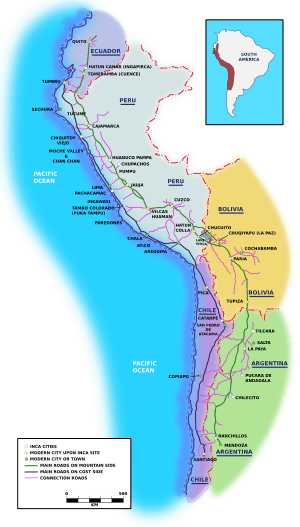Paria, Bolivia facts for kids
Paria, Bolivia was a really important place a long time ago. It was a big center for the Inca Empire in the late 1400s and early 1500s. It was also the very first place the Spanish settled in Bolivia, back in 1535.
The old ruins of Paria, sometimes called Paria la Vieja, are about 2 kilometres (1.2 mi) east of the small town of Paria today. That town had only 106 people in 2012. Paria is about 27 kilometres (17 mi) northeast of the city of Oruro. It sits in a farming valley, very high up at about 3,767 metres (12,359 ft) above sea level.
Paria is located in Cercado Province and the Oruro Department of Bolivia.
Paria and the Incas
Paria was a settlement for the Uru people even before the powerful Inca Empire came along. The Inca emperor Topa Inca Yupanqui (who ruled from 1471 to 1493) took control of the Paria area. He was expanding the Inca Empire south from its capital, Cuzco.
The emperor chose Paria to be the capital of a large area called Charcas province. This was a much bigger area than what is called Charcas today. Paria was a key stop for important goods. For example, maize (corn) grown in Cochabamba to the east would pass through Paria. It was either sent to Cuzco or stored right there in Paria.
Later, in the 1520s, soldiers gathered in Paria. They would then travel north to fight in the Inca military campaigns in the northern Andes mountains. Paria was located right on the royal road of the Inca Empire. This amazing road stretched all the way from Quito in the north to the Maule River in what is now Chile.
Under the Incas, Paria was a very important place. A Catholic priest once described it as "an administrative and military center." He said it was like "a miniature Cuzco." It had many smaller settlements under its control. From Paria, the Inca emperor ruled over Qullasuyu, which was one of the four main parts of the Inca Empire. Paria had temples for Inti, the Inca Sun god. It also had special places for ñustas (princesses), government buildings, military buildings, and storage silos (qullqas) for food. There were also lodging places called tambos where travelers could rest.
Paria and the Spanish
In 1535, a Spanish explorer named Diego de Almagro left Cuzco. His goal was to conquer new lands and find riches south of Cuzco. This area is now Bolivia and Chile. An advance group, led by Juan de Saavedra, arrived at Paria on January 23, 1535. This group included an Inca religious leader named Vila Oma and Paullu Inca, who was the brother of the Inca emperor, Manco Inca. There were also Augustinian priests, 150 Spanish soldiers, and hundreds of native soldiers.
When they arrived, the Spanish destroyed many of the Inca buildings. They then founded a new settlement called Paria La Nueva (New Paria). Almagro and most of his army arrived later that year. They then continued south to conquer more lands. The Augustinian priests who came with Saavedra started a church in Paria.
In 1565, the Spanish created a district called the Corregimiento of Paria. This district was part of Charcas Province. The Paria district existed until 1782. A count of people in the Paria district in the 1570s found about 2,500 households. This meant there were around 12,500 people living there. All the people counted were native Andeans, though a few Roman Catholic priests also worked in the area.
Today, the old church in Paria is very important. The Bolivian government has declared it a National Monument.
The Ruins of Old Paria
For a while, people weren't sure exactly where the old Inca and Spanish settlement of Paria la Vieja was located. But in 2010, an article pinpointed its location. It is about 2 kilometres (1.2 mi) east of the small town of Paria that exists today.
At this site, spread out over a large area of 100 hectares (250 acres), you can find the remains of big buildings. There are also more than 1,000 qullqas, which were storage buildings for grain. Pottery found at the site mostly dates back to the Inca period. This archaeological site is larger than any other known site in the area. This strong evidence helps confirm that this is indeed the important location of Paria la Vieja.
See also
 In Spanish: Paria (Bolivia) para niños
In Spanish: Paria (Bolivia) para niños


